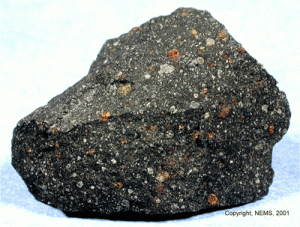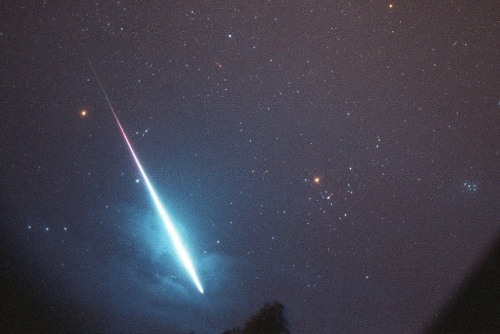Meteorites are in the news in two starkly different ways this week, but I’ll lead with a story that has implications for how planetary systems like ours are born. Philipp Heck (University of Chicago) and colleagues have been analyzing interstellar grains from the Murchison meteorite, a large object that fell near the town of Murchison, Victoria in Australia in 1969.

The Murchison grains are thought to have been blown into space by dying stars long before the formation of Earth. We’d like to know more about such grains because they became incorporated into the earliest solids forming in the Solar System, and hence offer a window into that era. Moreover, their composition helps us understand a bit more about their history. “The concentration of neon,” says Heck, “produced during cosmic-ray irradiation, allows us to determine the time a grain has spent in interstellar space.”
Image: A fragment of the Murchison meteorite. Copyright New England Meteoritical Services, 2001.
The interstellar travel time for these grains, however, turns out to be less than expected, falling into a range between three million and 200 million years, less than half the previous 500 million year estimate for interstellar space exposure. In fact, of the 22 grains studied, only three lived up to the longer estimate. A period of intense star formation one to two billion years before the Sun’s birth, one that produced large quantities of dust, could account for the early incorporation of the grains.
Seen in one light, objects like the Murchison meteorite are storehouses of information about the early Solar System. Seen in another, they and their larger cousins form a class of dangerous objects that could pose a threat we need to anticipate. On that score, we have, until recently, studied incoming objects by using satellites built to detect nuclear bomb tests. They’ve done priceless double-duty, offering up data on asteroids and meteoroids entering the atmosphere. Leonard David points out in a recent story that most incoming objects are never seen from the ground because they fall over ocean or in broad daylight.

Image: A fireball over Norway in 1998. Credit: Arne Danielsen.
But data on incoming bolides are now being treated as classified, and that’s bad news for the study of future impacts. The asteroid 2008 TC3, for example, was the first case of an astronomical detection of such an object before it hit. Data on the subsequent fireball from surveillance satellites proved crucial in locating the impact zone of this object in the Sudan. Tracking smaller impactors is a key part of the overall plan to study and identify dangerous Near Earth Objects, so let’s hope the scientific community can make this case clearly enough to cause policy-makers to reconsider.
The paper on the Murchison grains is Heck et al., “Interstellar Residence Times of Presolar SiC Dust Grains from the Murchison Carbonaceous Meteorite,” Astrophysical Journal 698 (2009), pp. 1155-1164 (abstract). A University of Chicago news release is available.


Here is a link to a Nature article on astronomer’s loss of access to information on incoming meteors (subscription required):http://www.nature.com/news/2009/090612/full/459897a.html .
“Image: A fragment of the Murchison meteorite”
So. Would that be the Mote in Murchison’s Eye?
Well said! For those who haven’t read it, The Moat Around Murcheson’s Eye, by Larry Niven and Jerry Pournelle, follows up the story of The Mote in God’s Eye, a story of alien encounter that features a beamed lightsail that arrives in our Solar System and the various things that result.
Announcement from Planetary Science Research Discoveries [PSRD]
New article online:
Better Know A Meteorite Collection: Natural History Museum in London, United Kingdom
———
ILLUSTRATED ARTICLE at:
http://www.psrd.hawaii.edu/July09/Meteorites.London.Museum.html
——— FIND ALL ARTICLES:
http://www.psrd.hawaii.edu/Archive/Contents.html
———
PSRD is an educational web site supported by NASA’s SMD Cosmochemistry Program and the Hawaii Space Grant Consortium to share the latest research on meteorites, planets, moons, and other bodies in our Solar System.
Cometary Origin of the Zodiacal Cloud and Carbonaceous Micrometeorites
Authors: David Nesvorny, Peter Jenniskens, Harold F. Levison, William F. Bottke, David Vokrouhlicky
(Submitted on 23 Sep 2009)
Abstract: The zodiacal cloud is a thick circumsolar disk of small debris particles produced by asteroid collisions and comets. The relative proportion in which these two source populations contribute to the zodiacal cloud and the exact physical mechanism that generates the bulk of observed dust were unknown.
Here we model the IRAS observations of thermal emission from asteroid and cometary particles to explain the origin of the zodiacal cloud. We find that >90% of the observed mid-infrared emission is produced by particles from the Jupiter-family comets (JFCs). We suggest that spontaneous disruptions of JFCs, rather than the usual cometary activity driven by sublimating volatiles, is the main mechanism that liberates cometary particles into the zodiacal cloud.
Our results imply that JFC particles dominate the accretion rate of micrometeorites by Earth. Since their atmospheric entry speeds are typically low, many large JFC grains should survive frictional heating and land on the Earth’s surface. This explains why most antarctic micrometeorites have primitive carbonaceous composition. The present mass of the inner zodiacal cloud at 10^4 times brighter during the Late Heavy Bombardment (LHB) epoch 3.85 Gyr ago, when the outer planets scattered numerous comets into the inner Solar System.
The bright debris disks with a large 24 um excess observed around mature stars may be an indication of similar events happening in those systems. We estimate that 10^{22}, 2×10^{21} and 2×10^{20} g of primitive dark dust material should have been accreted during LHB by the Earth, Mars and Moon respectively.
Subjects: Earth and Planetary Astrophysics (astro-ph.EP)
Cite as: arXiv:0909.4322v1 [astro-ph.EP]
Submission history
From: David Nesvorny [view email]
[v1] Wed, 23 Sep 2009 21:36:52 GMT (183kb)
http://arxiv.org/abs/0909.4322
December 30, 2009
Dreamtime Meteor Impact Found with Google Earth
Written by Steve Nerlich
Duane Hamacher a PhD student from Australia’s Macquarie University found an ancient meteor impact crater in a remote location of the Northern Territory by searching Google Earth and following clues from an ancient dreamtime legend told by the indigenous Arrernte people.
Mr Hamacher reported to the Sydney Morning Herald and other Australian newspapers that the Arrernte people’s legend about a star that fell into a waterhole called Puka in the valley where Kulaia, the serpent, lived – has led to the discovery of the ancient crater, which the research team he is part of propose to name Puka.
Full article here:
http://www.universetoday.com/2009/12/30/dreamtime-meteor-impact-found-with-google-earth-2/
February 15, 2010
Meteorite Holds Millions of Unidentified Organic Compounds
Written by Nancy Atkinson
A Murchison meteorite specimen at the National Museum of Natural History in Washington DC.
New analysis of the famous Murchison meteorite that crash-landed in Australia over 40 years ago shows the space rock contains millions of previously unidentified organic compounds. Researchers say the meteorite, which is over 4.65 billion old – and likely older than our Sun — offers evidence that the early solar system likely had a higher molecular diversity than Earth, and may offer clues to the origins of life on our planet.
Full article here:
http://www.universetoday.com/2010/02/15/meteorite-holds-millions-of-unidentified-organic-compounds/